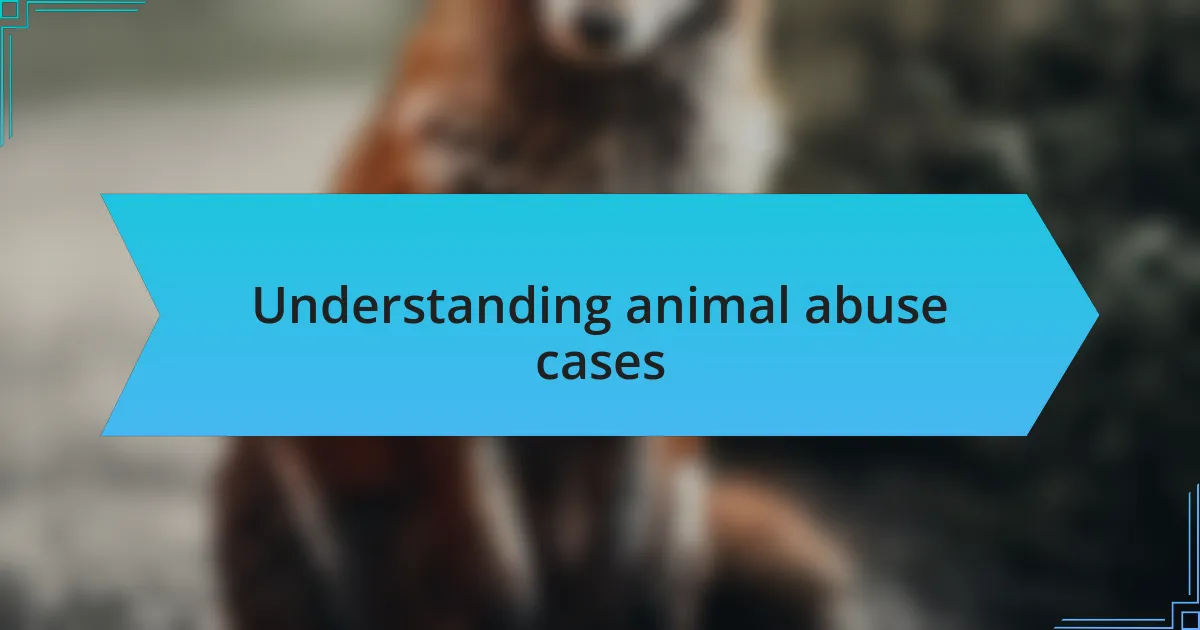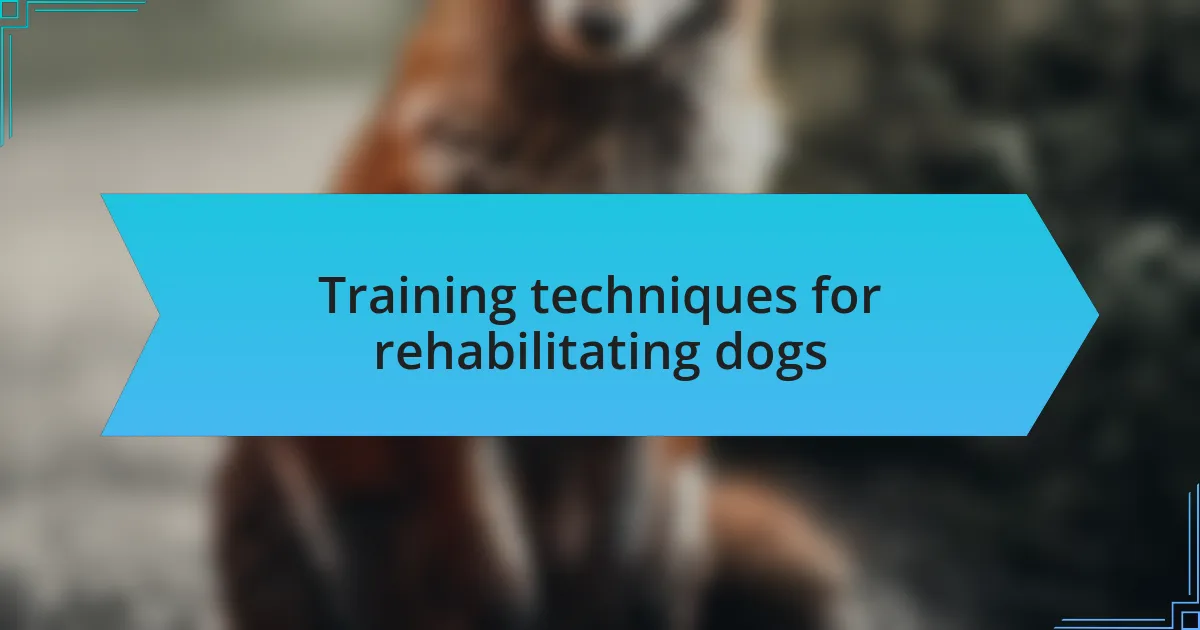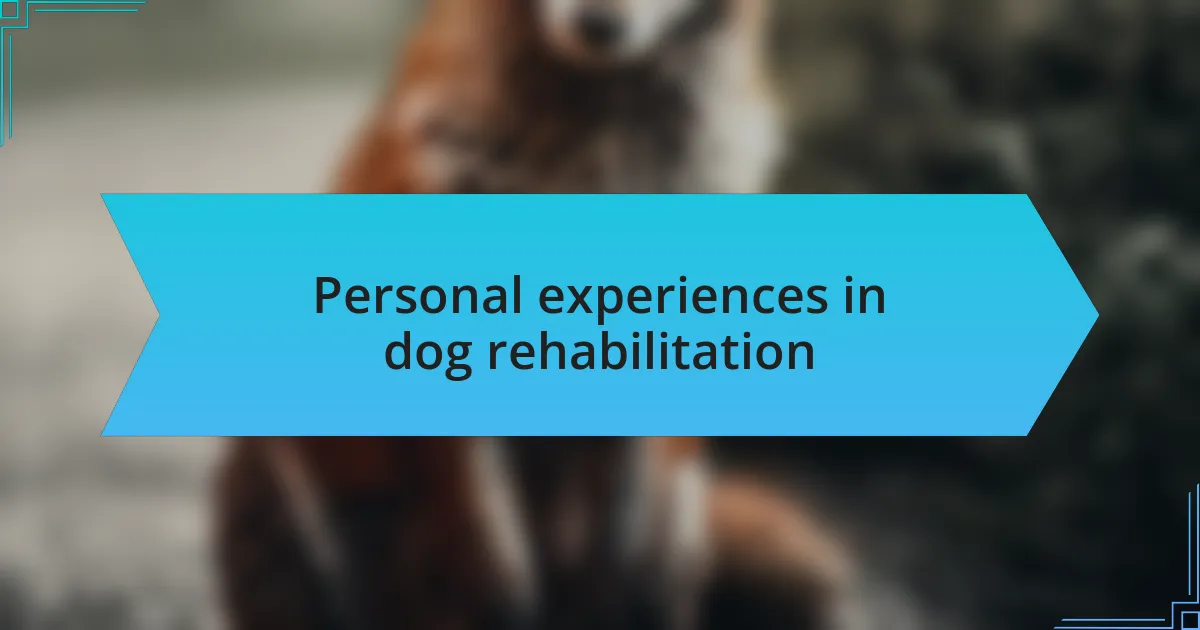Key takeaways:
- Animal abuse often stems from the abuser’s own trauma or neglect; understanding these roots can inform better interventions.
- Positive reinforcement and consistency in training are crucial techniques for rehabilitating abused dogs, helping them build trust and reduce anxiety.
- Socialization with other calm dogs can significantly aid in the rehabilitation process by boosting a fearful dog’s confidence.
- Creating a calm environment for abused dogs is essential, as it allows them to feel safe and reveal their true personalities over time.

Understanding animal abuse cases
Animal abuse is a heartbreaking reality that affects countless creatures. I remember one particularly eye-opening case where a local shelter took in a dog that had been starved and left in a filthy environment. It made me wonder—how can anyone justify harming such a vulnerable being?
Many individuals who abuse animals often mirror their own experiences of trauma or neglect. I once met a survivor of domestic abuse who found solace in rescuing animals, but their scars were evident. It really reminds us that understanding the roots of animal abuse can lead to more effective interventions.
It’s crucial to recognize the signs of abuse and act promptly. I’ve seen firsthand how a well-informed community can become the first line of defense for animals in distress. Have you ever questioned what might happen if we all took a stand? The power of awareness and compassion can make a world of difference in preventing further cases of abuse.

Training techniques for rehabilitating dogs
One effective training technique I found invaluable in rehabilitating an abused dog was positive reinforcement. When I first started working with Bailey, a timid pit bull, she would cower at any sudden movement. I quickly learned that rewarding her with treats and praise for small achievements—like making eye contact—encouraged her to build trust. Have you ever seen the magic that a simple “good girl” can do? It truly transformed our interactions.
Another technique that I believe can’t be overlooked is consistency in training. During the early days, I maintained a structured routine with Bailey, which made her feel secure. For example, we would practice commands like “sit” and “stay” daily, each time celebrating her progress. I was amazed at how routine lessened her anxiety. Isn’t it fascinating how dogs, especially those with a troubled past, thrive when they know what to expect?
Finally, socialization played a crucial role in Bailey’s rehabilitation. Initially, she was terrified of other dogs, but I gradually exposed her to calm, friendly canines in controlled environments. This was a game-changer. Watching her slowly approach and interact with other dogs filled me with hope. How rewarding is it to see a fearful creature blossom into a joyful companion? It truly underscored the importance of patience and transparency throughout the training process.

Personal experiences in dog rehabilitation
Working with Bailey, I experienced firsthand the profound need for compassion in dog rehabilitation. I remember the first time she crouched in a corner at the sound of a door creaking; it broke my heart. I sat on the ground, talking to her softly and offering her a gentle hand. It took several attempts, but eventually, she crept forward, her curiosity slowly replacing her fear. Have you ever witnessed a moment like that? It’s as if the dog is sharing a piece of their soul with you.
During our journey, I often reflected on how past abuse shapes behavior. I once encountered a situation where a loud noise startled Bailey, causing her to flinch and retreat. In that moment, I realized it wasn’t just about training commands; it was about understanding the scars she carried. I made it a point to create a calm environment, avoiding sudden movements and loud sounds. The difference was palpable—she began to relax, revealing layers of her personality I had yet to witness.
One impactful experience was our first trip to a pet-friendly park. Initially, Bailey froze at the sight of unfamiliar people and dogs. I could feel her anxiety radiating off her as I reassured her with soft words and gentle encouragement. When she finally took a brave step into the park, it felt like we had conquered a mountain together. Wasn’t it moving to watch her trust grow? Those moments of fear transforming into confidence are what keep me passionate about helping other animals heal.